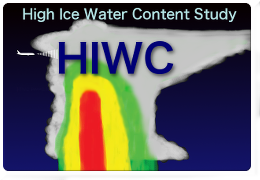HIWC Radar Study
High Ice Water Content Radar Study
The goal of the High Ice Water Content (HIWC) RADAR Flight Campaign is to develop a means to remotely identify regions of HIWC ahead of an aircraft to enable tactical detect and avoidance decision making by a flight crew. HIWC conditions occur in deep convective weather systems and have caused numerous engine power-loss events and air data system failures. Although new regulations will lead to more robust systems on newly certificated aircraft, legacy aircraft will benefit from improved forecasts and onboard identification methods to avoid encountering hazardous HIWC conditions.
The initial step towards that HIWC RADAR goal was to acquire radar data from a state of the art, commercial-off-the-shelf (COTS) pilot weather radar along with the corresponding in-situ cloud physics data (water content, particle spectra, temperature) during flights into deep convection. For three weeks, the NASA Armstrong Flight Research Center's DC-8 Airborne Science Laboratory was flown in and around deep convective systems, including tropical storms, in search of conditions that produce ice crystal icing conditions at high altitude. These data sets are being used to correlate the radar response to high ice water content conditions. Additionally, the data were used to supplement the database for Part 33 Appendix D/P regulations for engine and air data system certification and means of compliance.
Ultimately, this research will lead to technology onboard commercial aircraft to avoid high ice water content conditions and provide safe flight for all.
Principal Investigators
Tom Ratvasky, NASA
Steve Harrah, NASA
Project Manager
Ron Colantanio, NASA
Jim Riley, FAA
Data Manager
EOL Archive NCAR/EOL/DMS
